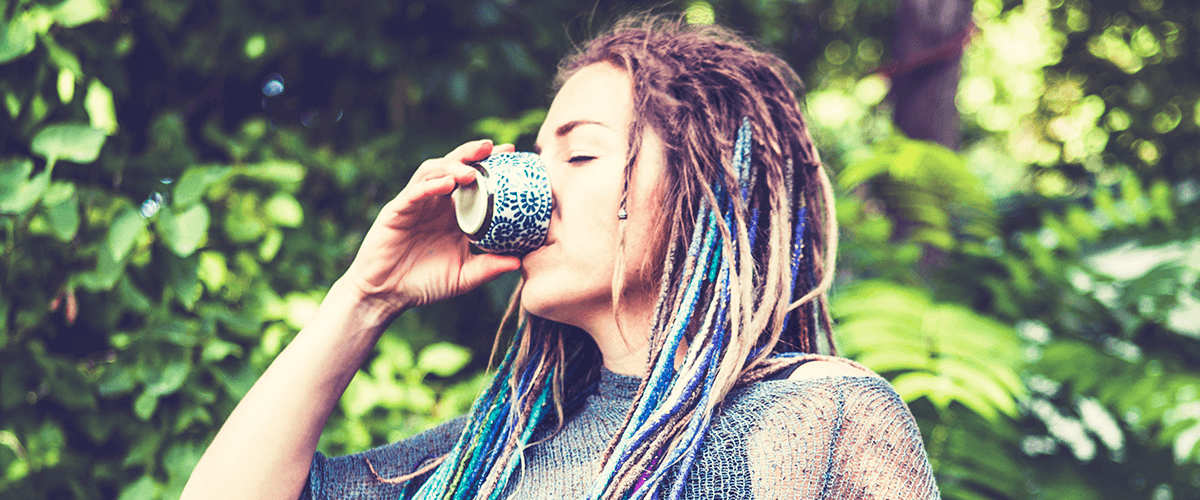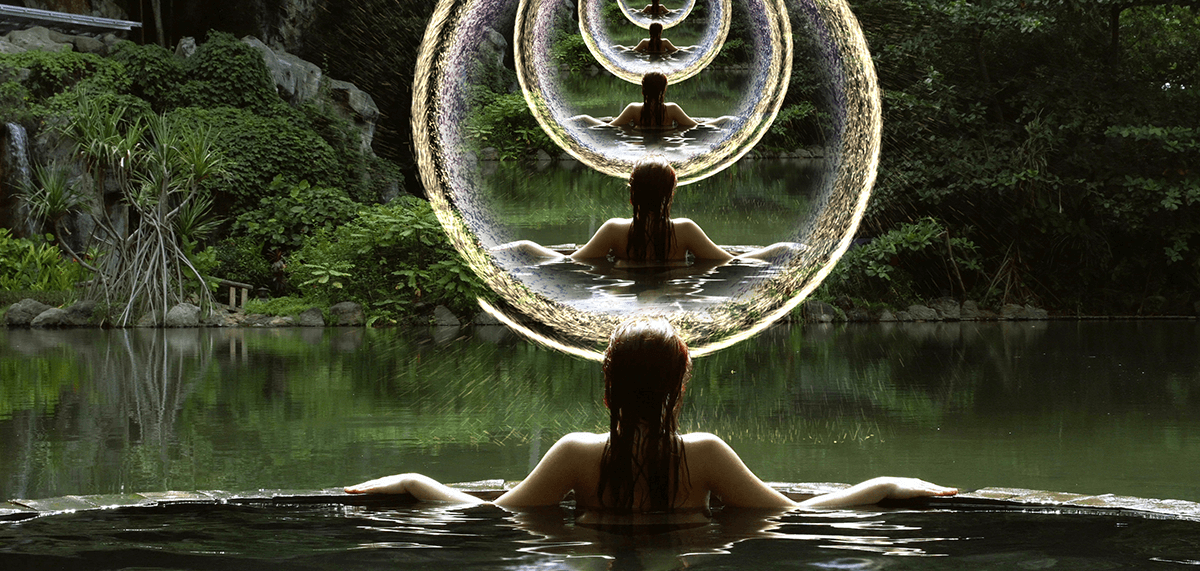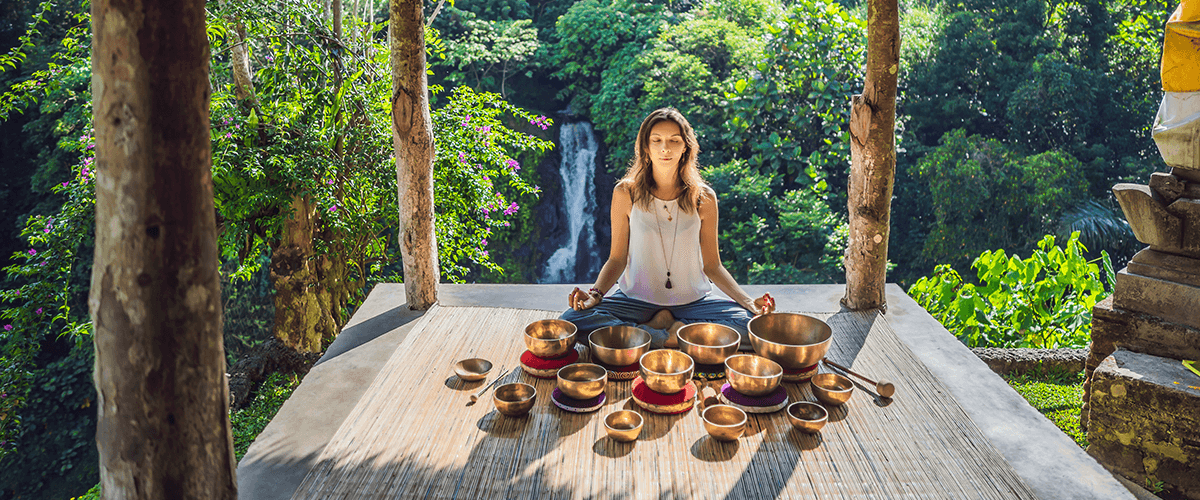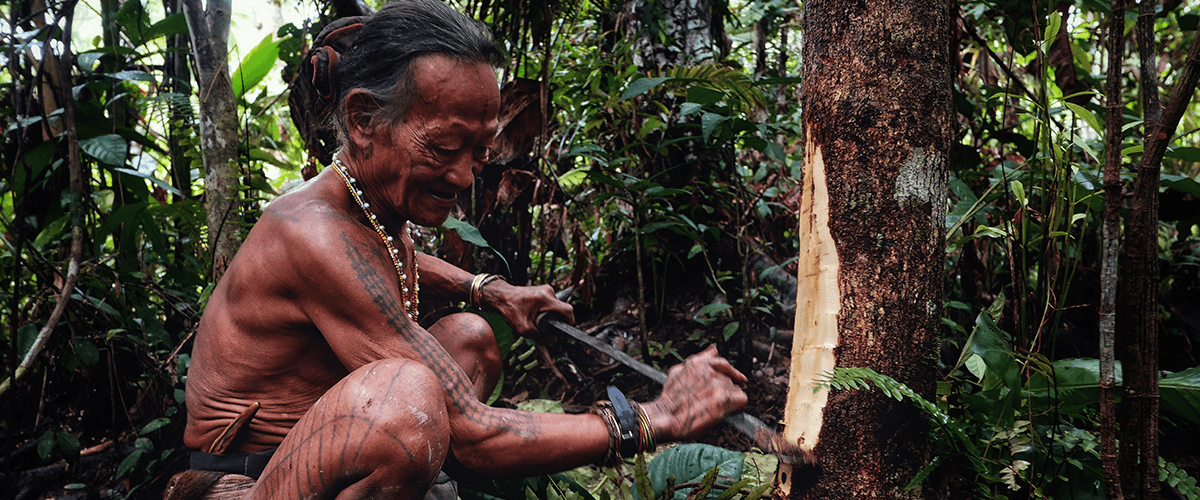
Ayahuasca, also known as yagé, yajé, caapi, cipó, bejuco de oro, hoasca, natem, shori, pilde, and many other names, is a traditional hallucinogenic tea made by indigenous communities of the Amazon rainforest in South America, particularly in Peru, Ecuador, Colombia, Bolivia, and Brazil. Part of their highly developed medicinal plant culture, the tea is used ceremonially by shamans, or "curanderos" (meaning "healers" in Spanish), and by their patients for purposes of physiological and spiritual healing and divination.
This brew entered the public eye with independent explorers venturing to the Amazon and writing about their experiences halfway through the 20th century. It has gained massive popularity in the last few decades, as it's been getting increasingly convenient to visit South America, with all the improvements in tourism infrastructure and the commercialization of this indigenous medicine.
Ayahuasca is most commonly made from:
DMT has become quite a familiar acronym not only in the psychedelic community, but in popular culture as well. This substance, dubbed The Spirit Molecule, is known to produce otherworldly transdimensional visions of extraordinary intensity and completely unintelligible sources. DMT is often smoked in its pure crystal form (freebase) or in a mix with various herbs that balance out and adapt the effect, known as changa. Freebase DMT requires being smoked because the human body (which has, ironically, actually been found to produce DMT endogenously) breaks down this molecule and doesn't allow it to cross the blood-brain barrier and perform its psychoactive function.
The MAOIs in the B. caapi vine, however, inhibit the monoamine oxidase enzymes which normally metabolize DMT, thus allowing the "spirit molecules" to remain intact and activate their target brain receptors. Taking DMT orally in ayahuasca actually makes its effect more intense and longer-lasting, which is evident when we compare the multi-hour-long ayahuasca journey duration to a 15-minute-long smoked DMT trip. The experiences themselves are, of course, wildly different, too.
B. caapi and P. Viridis make up the purest ayahuasca mix. Other ingredients are sometimes added to achieve various effects relating to potency, stability, and vision quality and intensity. Some shamans use different strains of the Banisteriopsis vine (which all cause different effects, according to indigenous belief), or add Nicotiana rustica (known as "mapacho" – ancient, sacred tobacco used in indigenous plant healing) to the brew. Others add strains of the Brugmansia flower (a highly psychoactive plant closely related to Datura – the "Devil's Trumpet"), some mix in the 5-MeO-DMT-containing Bufo Alvarius toad venom. Needless to say, some of these ingredients can be dangerous or even deadly when infused into ayahuasca, especially if their dose is miscalculated by an inexperienced shaman. This is one thing to be aware and cautious of when looking to drink the brew.
The traditional preparation of ayahuasca actually often used to include only the B. caapi vine and very small, if any, amounts of the DMT containing admixtures. The MAOI in the vine is what the indigenous people found to be the main healing agent of the brew; P. Viridis was one of the ingredients that stuck around as part of the formula due to the powerful and interesting visions the DMT inside it would induce in the drinker. Eventually, with the influx of Western visitors and their fascination with these incredible visions, DMT became a more and more present element in order to, more or less, "guarantee" the experience they came for.
The preparation of ayahuasca is fairly simple, but it involves a good deal of patience and care. One of the simpler recipes goes as follows: B. caapi is cut, washed, and then pounded with a mallet to break apart the veins of the vine. Its bark is laid down as a foundational layer, which is covered with P. Viridis leaves. The remainder of B. caapi is added, and then another layer of P. Viridis. Water is added, and the brew is cooked for 6h. After that, the liquid is strained and then filtered through a porous cloth; it is then reduced further until the desired consistency is achieved. The whole process lasts about 9h.

When ingested, ayahuasca induces some of the most powerful psychotropic effects available to the human experience. The effects start coming on slowly, and their intensity increases in gradual waves.
In the beginning, there is a mild sense of something being different, like a slight state of alertness we can feel in moments of noticing something we haven't noticed before. Soon come more substantial changes in perception, and they include all the senses. The environment isn't perceived regularly anymore, the awareness of one's own body and consciousness itself shifts to a different state. The lengths of things around us feel distorted, the ratios of dimensions skewed. Time seizes to be a regular and reliable tick of the clock and feels like it continuously contracts and elongates at its will. Bodily symptoms like alternating waves of feeling hot and cold can accompany these strange sensations, as can shivering, random pains and involuntary movements, and, notably, intense nausea and sudden vomiting or diarrhea.
Vomiting is a frequent (and notorious) side-effect of ayahuasca. According to the belief of indigenous people, the brew makes its drinkers purge (hence its alias "La Purga") all the toxins and impurities from their bodies, exacerbating their spiritual cleansing. This is no regular queasiness after a night of drinking, or gastric discomfort coming from eating questionable food; the vomiting that ayahuasca causes is on a whole other level. It's an intense, visceral feeling of something deeply wrong and disturbing being ripped out from your stomach. As harrowing as this may seem, the process actually provides a tremendous relief, and very few people look back on it as a negative experience.
As for the spiritual effects, ayahuasca takes its drinkers on a wild and complex rollercoaster ride through this and other realities. There's really no saying what it has in store for you, but, in one way or another, the experience does tend to be what the drinker needs at that point in their existence.
Some people experience a revision of memories or even past lives, getting to confront their traumas and unresolved or tucked-away issues head-on. Some have pleasant, loving journeys full of tranquility and encouragement. Some experience their ego dissolving into nothingness, to the point of complete spiritual separation from the body. Some have mild visions of transforming patterns, lights and colors, some get to feel the incredible comfort of a universally-pervading unity to which everything and everyone belongs, others see wild and vivid visions of incredible transdimensional landscapes, structures and entities and even get to interact and absorb wisdom from interacting with these otherworldly creations. And some… Well, some don't experience much at all.
With any psychedelic, and especially ayahuasca, the most important advice that can be given is: don't have expectations, embrace what comes without fear or judgment, and surrender completely to the experience. Even if it's nothing, it's nothing for a reason.
The whole journey usually takes off after about thirty minutes, peaks within the second hour after drinking, and ends after four to six hours, though there are significant individual variations in this. The comedown is quite quick but gentle, leaving the drinker in a peaceful afterglow, which can last for over a day. Ayahuasca is usually done at night, and by the time it's over, the body feels quite exhausted, and it's normally easy to fall asleep.

Although no one can really get ready for what the ayahuasca experience can bring, there are certain well-advised practices that are known to help the mind and body prepare for the journey.
Most retreat centers recommend upholding a kind of comprehensive fast, referred to as "la dieta", for three to five days before drinking ayahuasca. La dieta does not only relate to healthy nutrition but also to the maintenance of a psychosocioemotional purity in this time frame.
The advised restrictions include red meat, pork, fermented and aged foods, canned or packaged meat and fish products, protein or yeast-based extracts or supplements, dairy products (especially fermented ones), overripe fruits, processed sweets, refined sugar, as well as spicy and excessively salty foods. Additionally, ayahuasca drinkers should steer clear of coffee, alcohol (especially wine), illicit drugs, antidepressant medications and basically any other chronic drug therapy, and sexual activities for a period of three days before and after drinking ayahuasca.
As for the food, most of the recommended diet is there to help create a fresh and energetic bodily state. Eating white meat, fruits and vegetables, rice, cereals, beans, peas, and other legumes, with minimal amounts of fat and spices makes for a kind of a pre-detox that can get the body ready for the real cleansing that happens under ayahuasca's effects.
However, some of the restrictions are actually health-based and grounded in science. Fermented, cured, pickled, aged, and overripe foods, as well as certain beans, soy products, some cheeses, sourdough bread, draught beer, and especially wine, should be avoided before and after ayahuasca due to their tyramine content. Tyramine is a substance common to these f&b items, and it's been shown to interact negatively with MAOIs, the primary active compound of the B. caapi vine. Having a high level of tyramine in your system when ayahuasca enters it can cause a hypertensive crisis, which can, extremely, result in death.
Additionally, ayahuasca is not suitable for anyone with cardiac problems (especially hypertension, because the brew elevates blood pressure – this can lead to a hypertensive crisis and potentially death), depression (because the SSRIs often used for treating it can interact fatally with the MAOIs in ayahuasca), psychosis (because ayahuasca may exacerbate it), basically any illness that requires chronic medication (because the interactions of ayahuasca and Western medicine have not yet been explored fully, and there may be so far undiscovered dangerous combinations), and, of course, those with substance abuse disorders (because psychotropic substances influence the metabolism, and this can, in turn, influence how the body reacts to the brew).
A caveat here is that it may be possible to treat addiction with ayahuasca in the future. Still, this kind of therapy is pending scientific verification and institutional regulation. Until then, it's safest not to attempt using ayahuasca in the context of intervention.
Finally, before taking ayahuasca, it is recommended to maintain a kind of "psychological diet" for at least a few days. This refers to trying to avoid stress and negativity and focusing on setting your intention for going into the experience.
If deadlines, misunderstandings, heavy workloads, angry bosses, painstaking meetings, loss of revenue, gossip, and similar stressors sound like familiar elements of your work environment, it's well-advised to take a few days off. Otherwise, you'd also do well to distance yourself from any potentially disturbing or stressful events and toxic people. There may be a few of the latter around you that you're not even aware of, just waiting to express their judgment at your decision, so do yourself a favor and be selective about whom you're breaking the news to.
One more thing that needs to be mentioned – most retreat centers will recommend avoiding sexual relations and thoughts for a few days. This is up to your discretion, and you certainly won't be endangering your health like you would if you were to ignore the medicinal restrictions, but there is solid reasoning behind it. Firstly, sexual thoughts and deeds can be a big distraction in a time when you should be focused on understanding what you're trying to learn from the ayahuasca experience. Secondly, they can cause massive energetic shifts in your body, and ayahuasca works on your energetic (spiritual) being. Thirdly, it's not just your energy – normally, there are many others present in the ceremony, and you may make yourself vulnerable to others' energetic fields if yours is "shaken up" by sex. Indigenous people have an additional explanation; you can often hear the phrase "jealous lover" being associated with ayahuasca. "The 'mother plant' loves you and if you make love to another person, you are unfaithful to her".
In summary, the best you can do to prepare yourself for ayahuasca is to lead a wholesome life for a few days, eat plain, healthy food, avoid drugs and alcohol, stress and difficult social interactions, suspend any kind of chronic medication use (if possible) for at least ten days, meditate on what your intention should be, and – most important of all: relax and try to welcome whatever is coming your way.

Among the most important means of ayahuasca use in a traditional shamanic context is for the diagnosis of spiritual illness. Per the beliefs of the indigenous peoples of the Amazon, we can be afflicted by negative energies and evil spirits creatures sent out by others, causing a variety of bodily illnesses, some of which can be life-threatening. It is then the job of the shaman to drink ayahuasca and enter the spirit world, gaining the ability to see the origins and effects of this dark magic, and intuit the understanding of how to treat it.
Ayahuasca is also often taken by the ill, if the shaman believes that the Master Medicine should be applied. The brew has intense purgative effects, meaning that it often forces the drinker to vomit or defecate. This helps cleanse toxins and impurities from the body. The remainder of the healing effects of ayahuasca are psychological and spiritual – it can help create a more positive mindset (which, in turn, helps fighting illness) and strengthen the drinker's soul. Indigenous people also believe that the spirits of the jungle, often seen in visions, appear to help with the healing process.
Another important aspect of shamanic ayahuasca use is divination. When curanderos drink, their intuition is said to expand and transcend the dimensions of ordinary reality. They gain the power to communicate with the spirit world in order to ascertain the state of their community and prophesize what they should do to keep prospering. They are said to be able to locate missing people and objects, lead their community into the hunt by finding the game in the jungle, and see into the past to discover the perpetrator of a bad deed they are encharged with investigating.
Ayahuasca would often be used in a social context as well. According to anthropological research conducted by Bernd Brabec de Mori, indigenous communities would drink the brew together and engage in song and dance ceremonies, which would serve to strengthen their unity and communal spirit. Although ayahuasca ceremonies are marketed to foreigners as ancient rituals, it’s debatable how ancient they really are. There is evidence indicating that indigenous use of psychoactive plants, specifically DMT-containing yopo seed powder snuffs, goes back some three thousand years into the past. However, when exactly the indigenous people figured out that the combination and preparation of the two plants (out of the estimated 80,000 growing in the Amazon) yields the mystical hallucinogenic and divinatory potion we know today, and started using it in ceremonial purposes, is not known.
Over the last few decades, ayahuasca has become quite the object of international attention. Ever since the pioneers of ethnobotany such as Manuel Villavicencio, Richard Spruce, William Burroughs, Ralph Metzner, Richard Schultes, Terrence McKenna, Dennis McKenna, and Luis Eduardo Luna, to name a few of the greats, ventured into the Amazon to learn about indigenous plant medicines, the knowledge of their therapeutic and psychoactive potentials has been spreading worldwide throughout the psychedelic community. This has tempted many people yearning for spiritual evolution to go and experience the medicine, and some of them even to stay and learn the ways of shamanic practice, or help in one way or another with the institutionalization of these healing practices as services for Westerners.
This all has brought on what we now refer to as the "ayahuasca tourism boom". From being an addition to jungle tours meant only for the most adventurous, ayahuasca has evolved into the main attraction, driving up the influx of visitors mainly to Peru, but also to Ecuador and Colombia.
The use of ayahuasca today has mostly adapted to the needs of the Western visitors who have been shaping the scene for decades. All-inclusive retreat centers with high costs, but also high standards of security, support, and comfort, have become numerous. People travel to these retreats in the same way they would to a holiday resort, except the primary goal, instead of rest and relaxation, is – ego death.
Various centers across South America offer retreats ranging from a few days to a few weeks. Itineraries are carefully planned, and include space for orientation and preparation, one or more ayahuasca ceremonies depending on the retreat duration, traditional flower baths, optional kambo and rapé treatments, additional cleansings and consultations, sharing circles and other communal activities. Accommodation is comfortable, and surroundings are lush, shamans are thoroughly vetted, medical and security staff on duty 24/7 – everything is taken care of so that visitors can focus on their spiritual work. The only downside is that these kinds of retreats can be quite financially draining.
Alternative, more affordable and, arguably, more authentic ayahuasca ceremonies available to Western visitors involve traveling to the Amazon and finding individual shamans or shamanic families, and staying and drinking with them. These kinds of properties can generally not be found online, but they are quite numerous and mostly easily reachable. Knowledge of the Spanish language is more or less mandatory on these self-organized expeditions, and caution needs to be applied, as the capitalization of the ayahuasca experience has changed the healing landscape in the Amazon significantly. Aside from general matters such as shaman competency and the quality of the brew and ceremony, there are also safety concerns stemming from numerous accounts of sexual and other kinds of abuse.
Finally, there is always the DIY option. If you can source the B. caapi vine and the P. Viridis leaves (or their analogs), preparing ayahuasca is not such a difficult process. That said, of course, the years of practice that shamans undertake to be able to brew a powerful and potent potion are not for nothing, and of course you are ill-advised to drink ayahuasca alone. Whichever psychedelic you decide to take, and this especially applies to ayahuasca: always have a lucid sitter by your side in case something goes wrong.
Pharmahuasca is the latest in psychonautical attempts to replicate ayahuasca without the actual fresh ingredients. It's a pharmaceutical recipe that mixes the two main components that make up ayahuasca – an MAOI with DMT. For the MAOI, an extract of Peganum harmala (commonly known as "Syrian rue") is usually used, though it seems plants around the world might contain this type of chemical. The DMT part is usually just an extract of crystallized freebase N, N-DMT. The Syrian rue is usually boiled into a tea, and the N, N-DMT ingested orally, in a capsule. Although these are the bare-bones basics of ayahuasca, the results can be quite phantasmagorical. For dosages, trip reports, and any questions you may have, feel free to refer to the dmt-nexus forum thread on pharmahuasca.
As can be expected, one of the most potent psychedelics in the world is, of course, illegal in most countries; however, that's just a simplification of a complex and unclear situation. While the MAOI portion is legal, due to the DMT content the possession, distribution, and, often, use of the ayahuasca brew falls under the regulations governing Schedule 1 controlled substances under the United Nations 1971 Convention on Psychotropic Substances.
However, although DMT is an illegal substance, the UN drug office leaves it up to each country to decide whether ayahuasca can be exempt from that law. If a country doesn't have explicit regulations in place to regulate ayahuasca (and a surprising number doesn't), if a trial occurs it is up to the court to decide whether it will be judged in the same way as pure DMT (for example, in the US, the Supreme Court ruled in favor of this). A lot of countries have never had a legal case involving ayahuasca, and they normally have more important matters to deal with, so as long as its use doesn't stir up trouble, it is likely to not be given too much attention.
There is a caveat here – ayahuasca can be exempted from international law as a sacrament for religious use, such as within the Santo Daime Doctrine. This religious institution has a history of international arguing for the use of the brew in its rituals, and it's been allowed the exempt status in a few countries.
Peru, Ecuador, Colombia, Brazil, and Bolivia are countries belonging to the Amazon basin and homes to large populations of indigenous people who have been using this medicine for generations. In these countries, the possession and use of ayahuasca are legal, at times, subject to minimal regulation. The neighboring Chile and Argentina seem to have the brew classified as illegal, but enforcement is rare and unclear.
In North America and most of Europe, excluding Italy, Spain, and Portugal, which have unclear or no regulations, ayahuasca is explicitly illegal. In South Africa the status is grey. Finally, surprisingly, in Australia, although DMT is a Schedule 9 substance, possession of ayahuasca has in actuality not been subjected to legal persecution, and, conveniently, a few DMT-containing plants grow throughout the country.